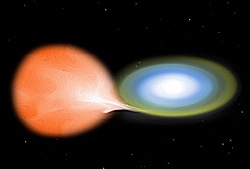A nova (plural novae or novas) is a transient astronomical event that causes the sudden appearance of a bright, apparently “new” star, that slowly fades over several weeks or many months. Causes of the dramatic appearance of a nova vary, depending on the circumstances of the two progenitor stars. All observed novae involve a white dwarf in a close binary system. The main sub-classes of novae are classical novae, recurrent novae (RNe), and dwarf novae. They are all considered to be cataclysmic variable stars.

Classical nova eruptions are the most common type. They are likely created in a close binary star system consisting of a white dwarf and either a main sequence, subgiant, or red giant star. When the orbital period falls in the range of several days to one day, the white dwarf is close enough to its companion star to start drawing accreted matter onto the surface of the white dwarf, which creates a dense but shallow atmosphere. This atmosphere, mostly consisting of hydrogen, is thermally heated by the hot white dwarf and eventually reaches a critical temperature causing ignition of rapid runaway fusion.
The sudden increase in energy expels the atmosphere into interstellar space creating the envelope seen as visible light during the nova event and in past centuries mistaken as a “new” star. A few novae produce short-lived nova remnants, lasting for perhaps several centuries. Recurrent nova processes are the same as the classical nova, except that the fusion ignition may be repetitive because the companion star can again feed the dense atmosphere of the white dwarf.
Novae most often occur in the sky along the path of the Milky Way, especially near the observed galactic centre in Sagittarius; however, they can appear anywhere in the sky. They occur far more frequently than galactic supernovae, averaging about ten per year. Most are found telescopically, perhaps only one every 12–18 months reaching naked-eyevisibility. Novae reaching first or second magnitude occur only several times per century. The last bright nova was V1369 Centauri reaching 3.3 magnitude on 14 December 2013.
Development
If a white dwarf has a close companion star that overflows its Roche lobe, the white dwarf will steadily accrete gas from the companion’s outer atmosphere. The companion may be a main sequence star, or one that is aging and expanding into a red giant. The captured gases consist primarily of hydrogen and helium. The gases are compacted on the white dwarf’s surface by its intense gravity, compressed and heated to very high temperatures as additional material is drawn in. The white dwarf consists of degenerate matter, and so does not inflate as its temperature increases, while the accreted hydrogen is compressed upon the surface. The dependence of the hydrogen fusion rate on temperature and pressure means that it is only when it is compressed and heated at the surface of the white dwarf to a temperature of some 20 million kelvin that a fusion reaction occurs; at these temperatures, hydrogen burns via the CNO cycle.
While hydrogen fusion can occur in a stable manner on the surface of the white dwarf for a narrow range of accretion rates, for most binary system parameters the hydrogen burning is thermally unstable and rapidly converts a large amount of the hydrogen into other heavier elements in a runaway reaction, liberating an enormous amount of energy, blowing the remaining gases away from the white dwarf’s surface and producing an extremely bright outburst of light. The rise to peak brightness can be very rapid or gradual and is related to the speed class of the nova; after the peak, the brightness declines steadily. The time taken for a nova to decay by 2 or 3 magnitudes from maximum optical brightness is used to classify a nova via its speed class. A fast nova will typically take less than 25 days to decay by 2 magnitudes and a slow nova will take over 80 days.
In spite of their violence, the amount of material ejected in novae is usually only about 1⁄10,000 of a solar mass, quite small relative to the mass of the white dwarf. Furthermore, only five percent of the accreted mass is fused during the power outburst. Nonetheless, this is enough energy to accelerate nova ejecta to velocities as high as several thousand kilometers per second higher for fast novae than slow ones with a concurrent rise in luminosity from a few times solar to 50,000 100,000 times solar. In 2010 scientists using NASA’s Fermi Gamma-ray Space Telescope were surprised to discover, for the first time, that a nova can also emit gamma-rays (>100 MeV).
A white dwarf can potentially generate multiple novae over time as additional hydrogen continues to accrete onto its surface from its companion star. An example is RS Ophiuchi, which is known to have flared six times (in 1898, 1933, 1958, 1967, 1985, and 2006). Eventually, the white dwarf could explode as a type Ia supernova if it approaches the Chandrasekhar limit.
Occasionally a nova is bright enough and close enough to be conspicuous to the unaided eye. The brightest recent example was Nova Cygni 1975. This nova appeared on 29 August 1975, in the constellation Cygnus about five degrees north of Deneb and reached magnitude 2.0 (nearly as bright as Deneb). The most recent was V1280 Scorpii which reached magnitude 3.7 on 17 February 2007.
Etymology
During the 16th century, astronomer Tycho Brahe observed the supernova SN 1572 in the constellation Cassiopeia. He described it in his book De stella nova (Latin for “concerning the new star”), giving rise to the name nova. In this work he argued that a nearby object should be seen to move relative to the fixed stars, and that the nova had to be very far away. Though this was a supernova and not a classical nova, the terms were considered interchangeable until the 1930s
